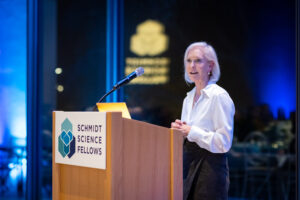How to spur scientific breakthroughs

Human knowledge and human connections should operate across divides, from the ivied walls between academic departments to the borders between countries.
If you’ve ever used an insulin pump, an over-the-counter pregnancy test, or a dose of remdesivir for COVID, you’ve benefited from interdisciplinary science.
And that’s only in medicine — cross-pollination also gave us smartphones and AI-driven software.
As we face multiple world crises, from climate destruction to the coronavirus pandemic, cross-collaboration is needed now more than ever — but the way scientists are trained actually makes this type of collaboration harder, if not impossible. Last week in Boston, we announced our fifth cohort of Schmidt Science Fellows. In our five years funding the program, we’ve learned that three barriers need to be overcome in order to accelerate interdisciplinary research and scientific breakthroughs: lack of funding, lack of incentives, and lack of community.
When we created Schmidt Science Fellows as the first program of Schmidt Futures in 2017, we set out to help scientists solve significant global problems faster by offering funding and a built-in community to postdoctoral candidates willing to work in a lab in a new field. The program is part of our broader mission to search for the next visionaries, betting early on the power of their ideas to solve hard problems in science and society. When the COVID-19 pandemic arose just a few years later, we saw the power of interdisciplinary collaboration in real time.
The Schmidt Science Fellows acted fast, like many of their peers worldwide. Many pivoted to work on COVID-19-related questions, from diagnostics to treatments, from understanding how the virus spread to the best vaccine rollout strategies. Fellow Shriya Srinivasan, who had been working on prosthetic limb development, switched to engineering ventilators, redesigning these life-saving devices so they could treat more than one patient at a time. Drawing on interdisciplinary expertise, Srinivasan worked to scale up the technology and was able to ship her device to hospitals worldwide and save thousands of lives.
Hal Holmes,meanwhile, had invented a handheld DNA scanner that could detect whether timber products came from endangered trees, or if fish being sold as tuna was actually tuna. Following a visit to his lab from another fellow, Fahim Farzadfard, the pair realized this scanner could be repurposed with new chemistry to also detect COVID. Farzadfard helped Holmes to adapt his invention and put it through trials to make it available to communities in need of rapid onsite testing.
Unfortunately, interdisciplinary expertise and collaborations like these are exceptions to the rule. The nation is in no position to address rapidly unfolding global crises without first eliminating the three main barriers to interdisciplinary work.
First, there needs to be more funding for interdisciplinary science at the higher-risk early stages. Many institutions provide this kind of support, notably the Defense Advanced Research Projects Agency, without which the COVID vaccine would not have been possible. But too much funding goes to less risky efforts that require scientists to already know, or have a strong sense, that their experiment will work. Funding is also frequently connected to specific disciplines.
Second, academia and other institutions that support science need to rethink incentives for young scientists. Scientific publications, tenure applications, and job promotions most often go to those who specialize in one area of study. Instead, we need to reward researchers who dare to think beyond the traditional bounds of a single discipline. Our program’s support has helped scientists win start-up ($36.8 million to date) and other research funding ($25 million to date). But the university system has to change as well.
Third, scientific leaders need to develop community between areas of expertise. Community is more than a simple sense of personal connection when it comes to science. Interdisciplinary thinking is challenging, and, as in much of scientific study, researchers fail a lot before they succeed. To keep working on a problem, to approach it in different ways and persist in finding a solution, scientists need supporters and thought partners. But as science is divided into ever more specific disciplines, each field protects its own turf and competes for funds and status with other areas of study. Campus communities like this often form the basis of hiring and promotion committees and offer little reward for interdisciplinary thinkers.
As we peer into a future filled with challenges that know no disciplinary boundaries, let us recognize that human knowledge, and human connections, should also operate across divides, from the ivied walls between academic departments to the borders between countries. Science was never meant to be narrow in purpose. At its plainest, the purpose of science is to feed our curiosity — and to keep us alive.
Eric and Wendy Schmidt are founders of Schmidt Futures, Schmidt Ocean Institute, and the Schmidt Family Foundation.